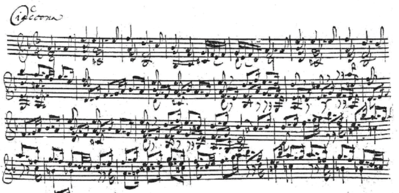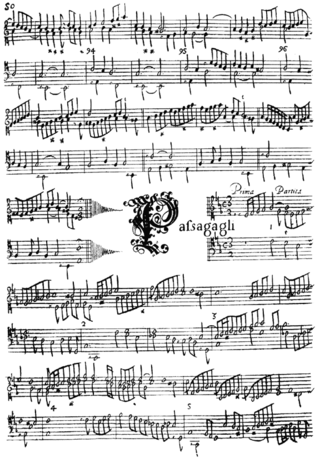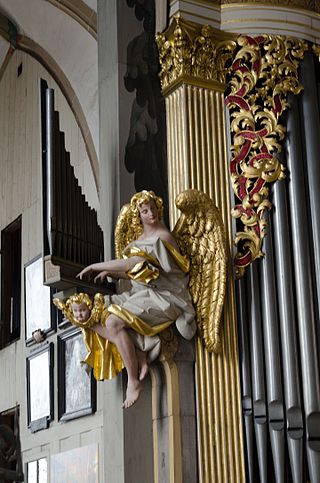
The Partita in D minor for solo violin (BWV 1004) by Johann Sebastian Bach was written between 1717 and 1720. It is a part of his compositional cycle called Sonatas and Partitas for Solo Violin.

The Partita in D minor for solo violin (BWV 1004) by Johann Sebastian Bach was written between 1717 and 1720. It is a part of his compositional cycle called Sonatas and Partitas for Solo Violin.
Except for the ciaccona, [lower-alpha 1] the movements are dance types of the time, and they are frequently listed by their French names: Allemande, Courante, Sarabande, Gigue, and Chaconne. The final movement is written in the form of variations, and lasts approximately as long as the first four movements combined.
Performance time of the whole partita varies between 26 and 32 minutes, depending on the approach and style of the performer.
Professor Helga Thoene suggests that this partita, and especially its last movement, was a tombeau written in memory of Bach's first wife, Maria Barbara Bach (who died in 1720), [2] though this theory is controversial. [3]
Yehudi Menuhin called the Chaconne "the greatest structure for solo violin that exists". [4]
Violinist Joshua Bell has said the Chaconne is "not just one of the greatest pieces of music ever written, but one of the greatest achievements of any man in history. It's a spiritually powerful piece, emotionally powerful, structurally perfect." He played the piece busking in L'Enfant Plaza for The Washington Post . [5]
Johannes Brahms in a letter to Clara Schumann described the piece, "On one stave, for a small instrument, the man [Bach] writes a whole world of the deepest thoughts and most powerful feelings. If I imagined that I could have created, even conceived the piece, I am quite certain that the excess of excitement and earth-shattering experience would have driven me out of my mind."
Bach's violin Ciaccona has been choreographed almost fifty times. [6]
Raymond Erickson has identified approximately two hundred transcriptions and arrangements of Bach's Ciaccona.

Since Bach's time, several transcriptions of the piece have been made for other instruments, particularly for the piano (including those by Ferruccio Busoni, Alexander Siloti, Joachim Raff, and Rudolf Lutz), and for the piano left-hand (by Johannes Brahms, [7] Paul Wittgenstein, and Géza Zichy).
Felix Mendelssohn and Robert Schumann each wrote piano accompaniments for the work.
Carl Reinecke transcribed the piece for piano duet.
The earliest version for organ is by William Thomas Best. Further transcriptions are by John Cook, Wilhelm Middelschulte, Walter Henry Goss-Custard (1915–55), and Henri Messerer (1838–1923).
In the preface to his 1955 transcription, John Cook writes: "The Chaconne is sublimely satisfying in its original form, yet many will agree that a single violin is only able to hint at the vast implications of much of this music … It is perhaps not unreasonable to suppose that Bach would have chosen the organ, had he transcribed the Chaconne himself, as the instrument best suited to the scale of his ideas … A good performance on the violin may be taken as the best guide to interpretation on the organ – the two instruments are not without their points in common, and both were beloved of Bach."
There is a transcription of the Chaconne for solo cello made by cellist Johann Sebastian Paetsch in 2015. This has been published by the Hofmeister Musikverlag in Leipzig. [8]
The Chaconne is often performed on guitar. Marc Pincherle, Secretary of the French Society of Musicology in Paris, wrote in 1930: "If, insofar as certain rapid monodic passages are concerned, opinion is divided between the violin and the guitar as the better medium, the guitar always triumphs in polyphonic passages; that is to say almost throughout the entire work. The timbre of the guitar creates new and emotional resonance and unsuspected dynamic gradations in those passages which might have been created purely for the violin; as for instance the variations in arpeggi." [9]
The most well-known transcription for guitar is the Segovia transcription. Many guitarists today prefer to play the Chaconne directly from the violin score. [10]
There are a number of transcriptions of the Chaconne for orchestras of different sizes, including Leopold Stokowski's transcription for a full symphony orchestra. [11]
Gustav Leonhardt arranged the Partita for harpsichord solo. [12] Anne Dudley arranged Bach's Chaconne for piano trio, and a recording by the Eroica Trio appears on their Baroque album. The Chaconne has also been arranged for harpsichord by Pieter-Jan Belder and for violin plus four voices by Christoph Poppen and the Hilliard Ensemble. The Chaconne was masterfully transcribed for pedal harp by Dewey Owens, published by Lyra, and also by Skaila Kanga. [13]
In 2005 Joseph C. Mastroianni published Chaconne The Novel. Milo, abandoned by the father who introduced him to Chaconne, studied in Spain for four years to master the piece. [14]
In 2008 Arnold Steinhardt, the violin soloist and first violinist of the Guarneri String Quartet, published Violin Dreams, a memoir about his life as a violinist and about his ultimate challenge: playing Bach's Chaconne. [15]
In 2017 Márta Ábrahám and Barnabás Dukay published a book about Bach's Chaconne: Excerpts from Eternity – The Purification of Time and Character, the Fulfilment of Love and Cooperation with the Celestial Will in Johann Sebastian Bach's Ciaccona for Violin.
Notes
References
Sources

A chaconne is a type of musical composition often used as a vehicle for variation on a repeated short harmonic progression, often involving a fairly short repetitive bass-line which offers a compositional outline for variation, decoration, figuration and melodic invention. In this it closely resembles the passacaglia. It originates and was particularly popular in the Baroque era; a large number of Chaconnes exist from the 17th- and 18th- centuries.

The passacaglia is a musical form that originated in early seventeenth-century Spain and is still used today by composers. It is usually of a serious character and is typically based on a bass-ostinato and written in triple metre.

Toccata is a virtuoso piece of music typically for a keyboard or plucked string instrument featuring fast-moving, lightly fingered or otherwise virtuosic passages or sections, with or without imitative or fugal interludes, generally emphasizing the dexterity of the performer's fingers. Less frequently, the name is applied to works for multiple instruments.

The sonatas and partitas for solo violin are a set of six works composed by Johann Sebastian Bach. They are sometimes referred to in English as the sonatas and partias for solo violin in accordance with Bach's headings in the autograph manuscript: "Partia" was commonly used in German-speaking regions during Bach's time, whereas the Italian "partita" was introduced to this set in the 1879 Bach Gesellschaft edition, having become standard by that time. The set consists of three sonatas da chiesa in four movements and three partitas in dance-form movements. The 2nd Partita is widely known for its Chaconne, considered one of the most masterly and expressive works ever written for solo violin.
D major is a major scale based on D, consisting of the pitches D, E, F♯, G, A, B, and C♯. Its key signature has two sharps. The D major scale is:
E minor is a minor scale based on E, consisting of the pitches E, F♯, G, A, B, C, and D. Its key signature has one sharp. Its relative major is G major and its parallel major is E major.

Maria Barbara Bach was a German singer and the first wife of composer Johann Sebastian Bach. She was also the daughter of his father's cousin Johann Michael Bach.

Passacaglia and Fugue in C minor is an organ piece by Johann Sebastian Bach. Presumably composed early in Bach's career, it is one of his most important and well-known works, and an important influence on 19th- and 20th-century passacaglias: Robert Schumann described the variations of the passacaglia as "intertwined so ingeniously that one can never cease to be amazed."

Johann Sebastian Paetsch is an American cellist and musician.
Laszlo Varga was a Hungarian-born American cellist who had a worldwide status as a soloist, recording artist, and authoritative cello teacher.

Prelude and Fugue in A minor, BWV 543 is a piece of organ music written by Johann Sebastian Bach sometime around his years as court organist to the Duke of Saxe-Weimar (1708–1713).

Piotr Anderszewski is a Polish pianist and composer.

The Partita No. 3 in E major for solo violin, BWV 1006.1, is the last work in Johann Sebastian Bach's set of Sonatas and Partitas. It consists of the following movements:
This is the discography for Tanya Anisimova.

The Bach-Busoni Editions are a series of publications by the Italian pianist-composer Ferruccio Busoni (1866–1924) containing primarily piano transcriptions of keyboard music by Johann Sebastian Bach. They also include performance suggestions, practice exercises, musical analysis, an essay on the art of transcribing Bach's organ music for piano, an analysis of the fugue from Beethoven's 'Hammerklavier' sonata, and other related material. The later editions also include free adaptations and original compositions by Busoni which are based on the music of Bach.

The Chromatic Fantasia and Fugue in D minor, BWV 903, is a work for harpsichord by Johann Sebastian Bach. Bach probably composed it during his time in Köthen from 1717 to 1723. The piece was already regarded as a unique masterpiece during his lifetime. It is now often played on piano.

Excerpts from Eternity is a book presenting a detailed analysis of the structure of Johann Sebastian Bach's renowned Chaconne from his Partita for Violin No. 2, BWV 1004, and explores the essential context of its external and internal forms and proportions. Its full title is The Purification of Time and Character, the Fulfilment of Love and Cooperation with the Celestial Will in Johann Sebastian Bach's Ciaccona for Violin. The authors unravel the secret of the Chaconne; this new remarkable discovery is unique even in the field of art history: a time-code which has been lying dormant for almost 300 years. The book was published in Hungarian, Részletek az örökkévalóságból, and English in 2017.